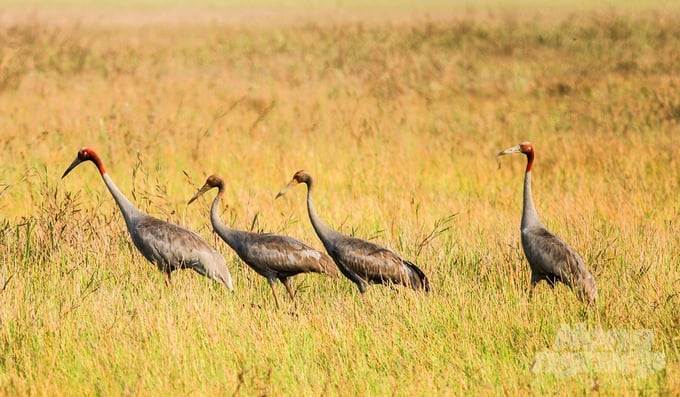November 27, 2025 | 20:51 GMT +7
November 27, 2025 | 20:51 GMT +7
Hotline: 0913.378.918
November 27, 2025 | 20:51 GMT +7
Hotline: 0913.378.918

Four red-crowned cranes were reported to have returned to Tram Chim National Park in Tam Nong District, Dong Thap Province in early 2024. Photo: Le Hoang Vu.
The Conservation Center of Tram Chim National Park, Tam Nong District, Dong Thap province, revealed on March 8 that four red-crowned cranes were spotted in the vicinity of Zone A5 on the afternoon of March 7. Reportedly, Zone A5 has been a familiar feeding ground for the cranes. Subsequently, the cranes circled the area for several hours for observation before settling down to forage for approximately half an hour.
The group of four cranes returning to Tram Chim National Park serves as an advance team to thoroughly survey the area before making a decision to settle for the entirety of the migration season. Crane migration typically begins in December as the Mekong Delta provinces enter the dry season, and lasts until the end of April. Cranes are often regarded as instinctual species, indicating only the most pristine environments. The return of the red-crown cranes to Tram Chim National Park after an extended period of absence stands as a positive signal for the local habitat.
According to researchers, the red-crown crane is a rare and endangered species listed in both the Vietnamese and global red books. These birds are characterized by their red-headed and feathered necks, with gray patterns on their wings and tails. An adult crane stands between 1.5 and 1.8 meters tall, with a wingspan between 2.2 and 2.5 meters, and a weight between 8 and 10 kilograms. Cranes typically mate at three years old. Subsequently, they breed and nurture their offspring for a year before laying the next clutch.
Cranes often choose Tram Chim as their migration destination in Vietnam towards the end of the year and the beginning of the following year. The highest number of cranes recorded at the National Park was roughly 1,000 individuals. However, this figure has gradually declined over the years. According to statistics from Tram Chim National Park, only 21 cranes returned in 2015, followed by 14 in 2016, 9 in 2017, 11 in 2018, and 11 in 2019. Reportedly, no cranes returned in 2020, and only 3 returned in 2021 before disappearing for two more years.
The reason for this scarcity has been attributed to changes in the ecological environment within the park. Reduced flooding prevents the washing away of the surface vegetation, thereby reducing the local fish population, a primary food source for the cranes.
As a result, some experts believe that the return of the cranes coincides with the changes in the management of the ecological environment at Tram Chim National Park. Notably, the Park shifted from water storage for forest fire prevention to natural regulation, prioritizing biodiversity conservation at the beginning of 2024. Namely, the waterlogged grasslands, which is a preferred destination of the cranes, were drained two months prior. Additionally, the top layer of the surface vegetation was burnt, allowing for the cultivation of tubers, which is a favorite food source of the cranes.
Prior to the return of the cranes, Dong Thap Provincial People's Committee organized a press conference to approve the crane conservation project with a total investment of 185 billion Vietnamese dong, which will be implemented over a period of 10 years. According to the project plan, the province will receive a transfer of 60 pairs of cranes from Thailand. The province will subsequently increase the flock by an additional 40 individuals. After the nurturing and training stages, the cranes will be released back into the wild at Tram Chim National Park. However, to date, the cranes have not been returned to the park.
Tram Chim National Park has been recognized as the world's 2,000th Ramsar site since 2012 and the first in the Mekong Delta, covering an area of over 7,300 hectares. The Park is one of the habitats of the red-crowned crane, and an important factor contributing to the park's Ramsar designation.
The red-crowned crane was rediscovered at Tram Chim in 1985. The number of cranes recorded at Tram Chim in 1988 was 1,058 individuals. Between 1988 and the late 1990s, Tram Chim consistently recorded the highest number of red-crowned cranes in the lower Mekong River region. The presence of the red-crowned crane was critical to the establishment of the Tram Chim wetland conservation area, the precursor to the present-day Tram Chim National Park.
Translated by Nguyen Hai Long

(VAN) On November 27, in the meeting with Minister Tran Duc Thang, Mayor Yin Yong shared Beijing’s experience to improve environment and air quality.

(VAN) After 30 years, both sides identified strategic areas of cooperation: sustainable production, increasing coffee value and training for farmers.
/2025/11/27/4910-4-164708_294.jpg)
(VAN) On the afternoon of November 27 in Beijing, Minister of Agriculture and Environment Tran Duc Thang held a working session with several major Chinese enterprises operating in the agriculture and environment sector.

(VAN) The Department of Animal Health issued a provisional guideline requesting local authorities to increase surveillance, collect samples for testing, and conduct epidemiological investigations according to the established procedure.

(VAN) The United Nations recommends that Vietnam utilize data and artificial intelligence to enhance early disaster warnings and reduce GDP losses by 3.2% in the context of climate change.

(VAN) On the morning of November 27 in Beijing, Minister Tran Duc Thang and the Deputy Commissioner General of the General Administration of Customs of China signed a protocol on fresh jackfruit exports.

(VAN) As floodwaters recede, a vast network of irrigation works across eastern Gia Lai is emerging in a state of severe disrepair, with extensive damage demanding urgent restoration ahead of the 2025-2026 winter-spring cropping season.